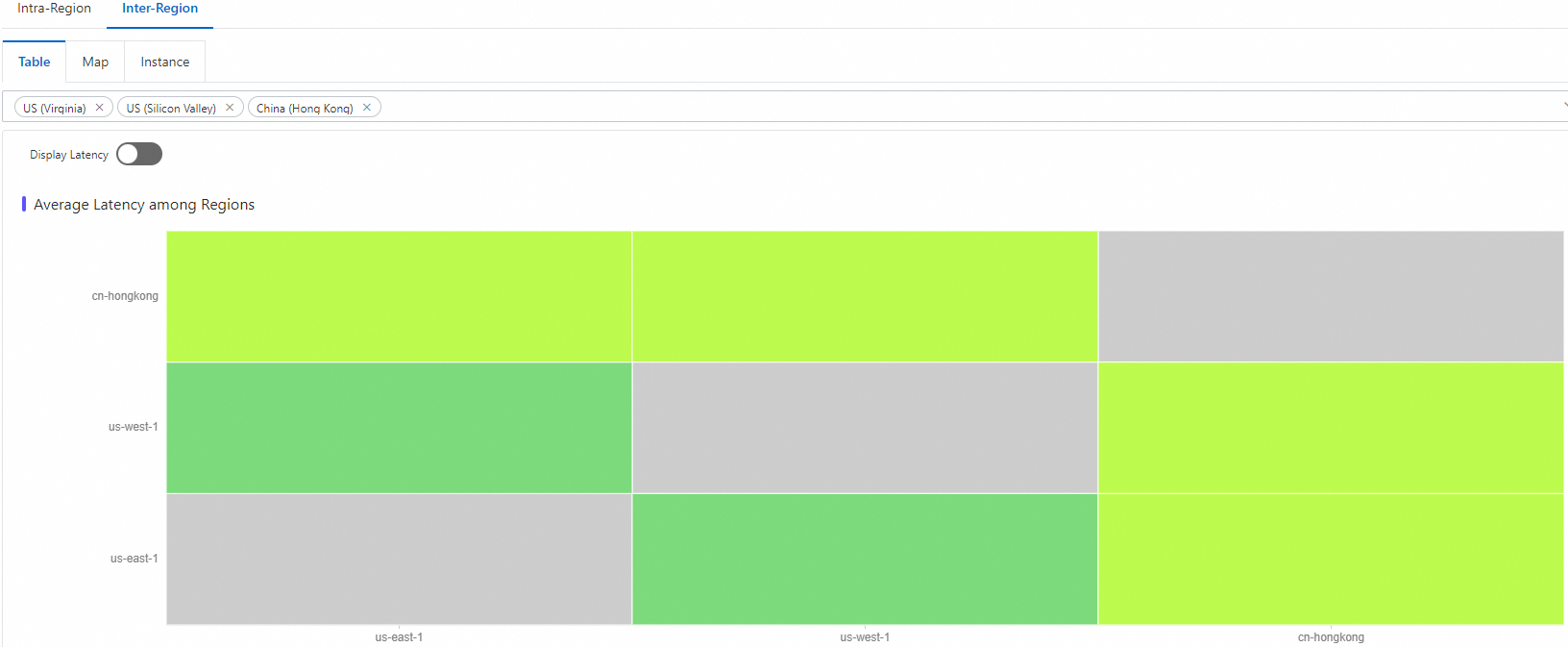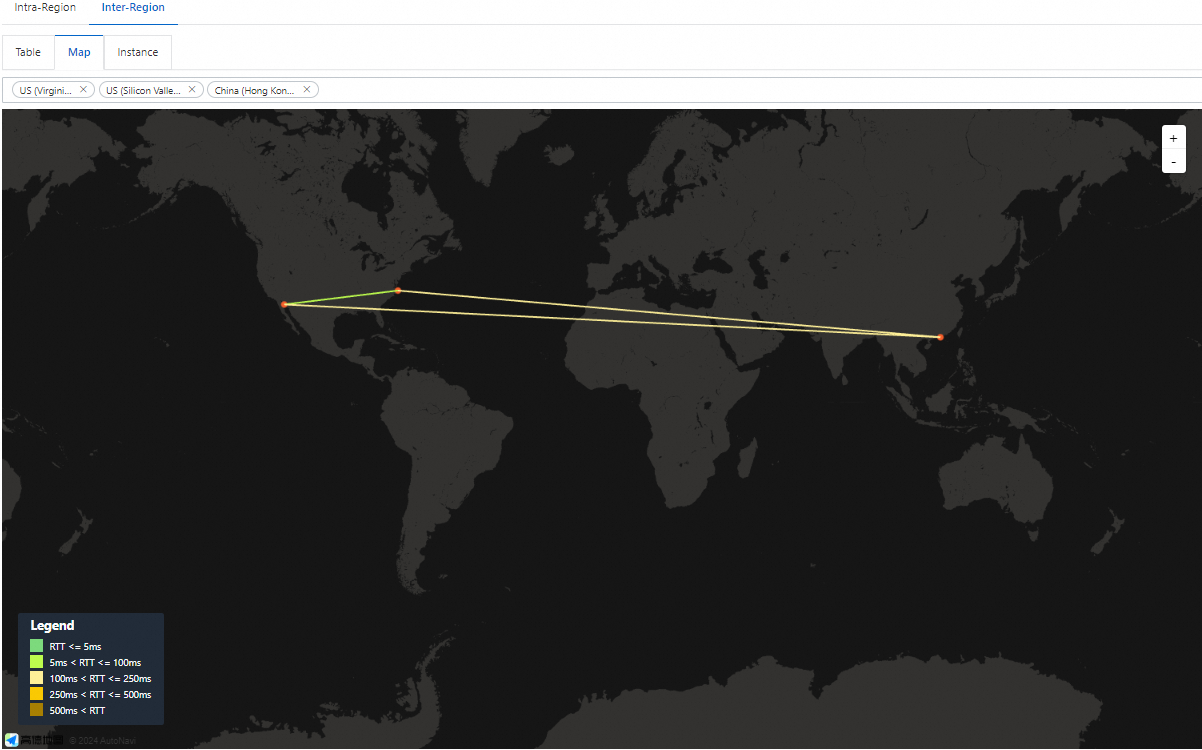Cloud Network Performance displays the average network latency between Alibaba Cloud zones and regions. You can use this data to select a suitable region or zone when you build your services. After you create an inter-region connection for an Enterprise Edition transit router, you can also view the latency of the physical link for the inter-region connection. This helps you select a link type that best suits your business requirements.
Disclaimer
The performance data, such as network latency, provided by Cloud Network Performance is for reference only. Alibaba Cloud does not guarantee the accuracy or timeliness of the data. The actual network performance is subject to real-world operating conditions.
The network latency displayed in Cloud Network Performance is measured by a dedicated probing cluster of ECS instances built by Alibaba Cloud. This cluster periodically sends and receives performance probing packets across the network. The aggregated statistical data is then displayed on the performance monitoring page. The test machines in the probing cluster are independent of tenants. Therefore, they do not affect or consume any of your resources, and the performance monitoring data is unrelated to the resources that you deploy on Alibaba Cloud.
Supported regions
Area | Supported regions for cloud network interconnection performance monitoring |
China | China (Qingdao), China (Beijing), China (Zhangjiakou), China (Hohhot), China (Ulanqab), China (Hangzhou), China (Shanghai), China (Nanjing - Local Region) (Closing down), China (Fuzhou - Local Region) (Closing down), China (Shenzhen), China (Heyuan), China (Guangzhou), China (Chengdu), and China (Hong Kong) |
Asia-Pacific | Japan (Tokyo), South Korea (Seoul), Singapore, Malaysia (Kuala Lumpur), Indonesia (Jakarta), Philippines (Manila), and Thailand (Bangkok) |
Europe and Americas | US (Silicon Valley), US (Virginia), Germany (Frankfurt), and UK (London) |
Middle East | UAE (Dubai) and SAU (Riyadh - Partner Region) |
Cloud network intercommunication performance metrics
Network performance within a region: The network latency for access between ECS instances in the same region.
The average latency for access between ECS instances in different zones of the same region.
The Alibaba Cloud probing clusters do not cover all zones, so data for some zones may be unavailable. The data displayed in the console is the authoritative source.
Network performance between regions: The latency for access between network instances in different regions.
The average latency for access between ECS instances in different regions.
The reference latency for Platinum or Gold links of an inter-region connection of an Enterprise Edition TR. The statistical metrics are as follows:
P10: The value at the 10th percentile of a dataset sorted in ascending order.
P50: The value at the 50th percentile of a dataset sorted in ascending order, which is the median.
P90: The value at the 90th percentile of a dataset sorted in ascending order.
View network performance within a region
Log on to the NIS console.
In the navigation pane on the left, choose .
On the Intra-region Network Performance tab, click Compute Instance Connection.
Select the region for which you want to view the latency.
Turn on the Display Latency switch to view the latency data.
The following describes the Average Latency Between Zones heatmap:
The x-axis and y-axis represent the zones of the selected region.
Each colored block represents the average latency of a connection from an ECS instance in a zone on the x-axis to an ECS instance in a zone on the y-axis. If a block corresponds to the same zone on both axes, it represents the average latency between ECS instances within that zone.
The Alibaba Cloud probing clusters do not cover all zones, so data for some zones may be unavailable. The data displayed in the console is the authoritative source.
Click a colored block in the Average Latency Between Zones heatmap. A line chart appears that shows the latency history for the previous hour.
View network performance between regions
Log on to the NIS console.
In the navigation pane on the left, choose .
On the Cloud Network Performance page, click the Inter-region Network Performance tab to view the following latency data.
View the average cross-region access latency between ECS instances
Click the Table View or Map View tab. Then, select regions to view the bidirectional latency between instances in the destination regions.

 Note
NoteBy default, the Map View tab displays the real-time average latency of the links between each pair of the following three regions: US (Virginia), US (Silicon Valley), and China (Hong Kong).
On the Map View tab, click View Details on any link. A line chart appears that shows the latency history for the previous hour.
View the reference latency of the physical link for a CEN inter-region connection
Click the Instance View tab. Then, configure the following parameters and click View Inter-region Latency.
Parameter
Description
CEN instance ID
Select the ID of the CEN instance to which the destination TR belongs.
Region
Select the destination region of the inter-region connection.
Inter-region connection instance ID
Select the instance ID of the inter-region connection.
Time
Select the time range for which you want to view the reference latency data. You can also specify a custom time range.
You can query data from the last 7 days. The earliest start time that you can select is 7 days ago.
NoteBy default, the average latency data for the P50 metric of Gold and Platinum links is displayed. You can view the data for the P10 and P90 metrics as needed.